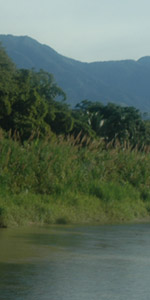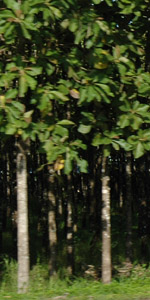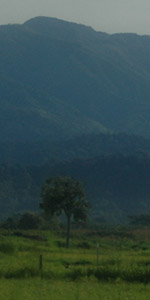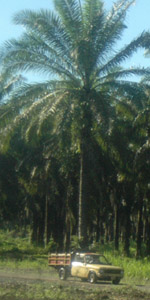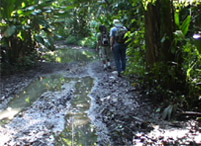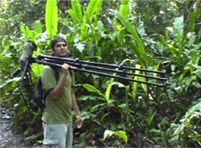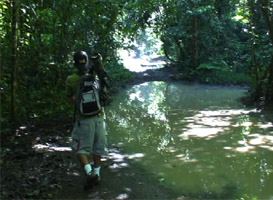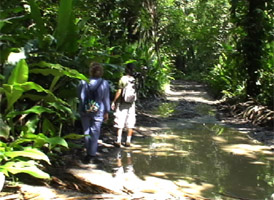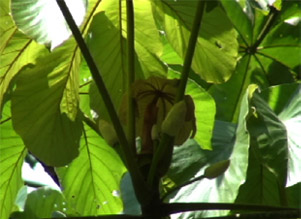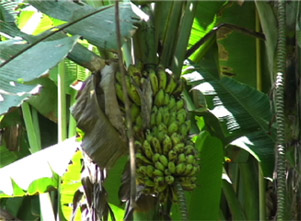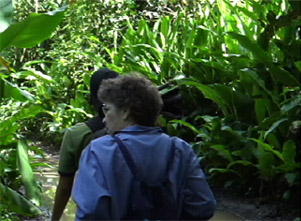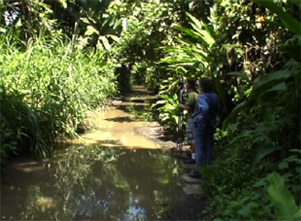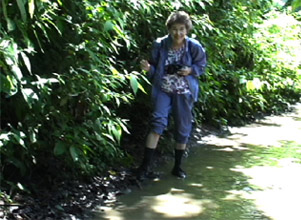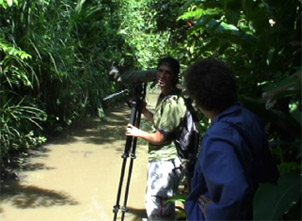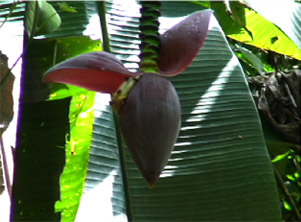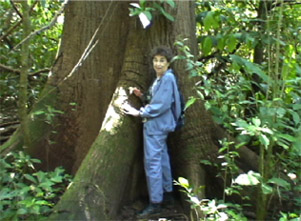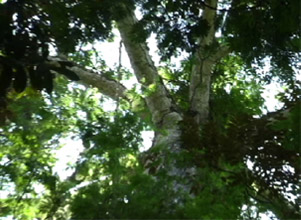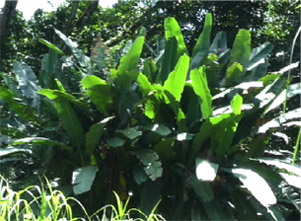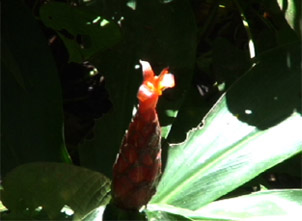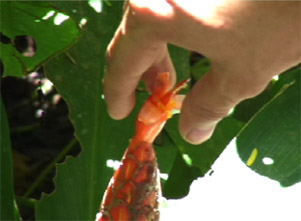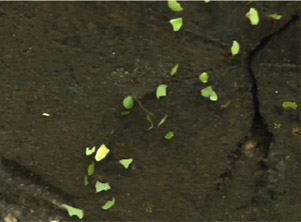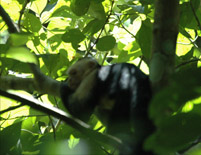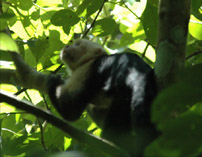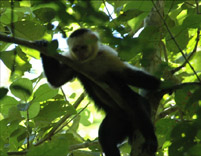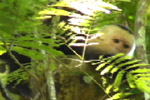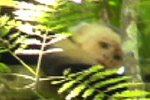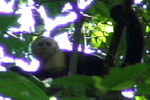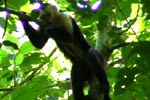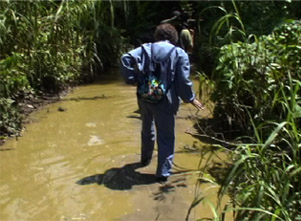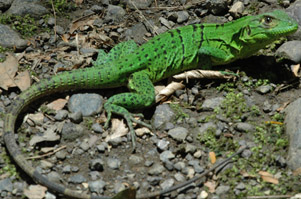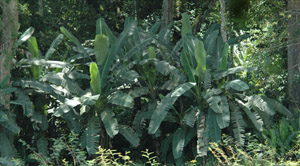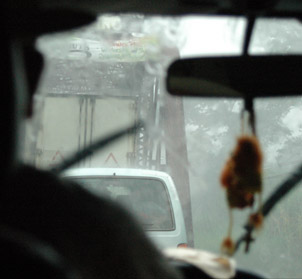Carara Biological Reserve
Saturday, September 2, 2006
The Carara Biological Reserve is one of Costa Rica's most biologically-diverse National Parks. It is home to an enormous variety of plants, birds and animals, including about 300 scarlet macaws.
Click on map text for any area.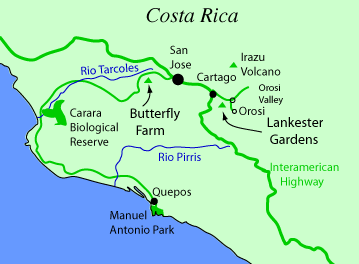 | Carara is located in a transitional zone rainforest area: it is between the dry North Pacific Coast and the very wet South Pacific Coast. Thus, Carara features plant and animal species from both areas. There is a tremendous abundance of wildlife in this area. Thousands of species of trees, heliconias, tillandsia, orchids, insects, mammals and birds live in Carara. Some of these species are native only to the Central Pacific Coast region.
|
 | We had arrived in Quepos yesterday afternoon and settled in to the Si Como No resort near Manuel Antonio Parque. We had made reservations for an early pickup for a guided tour of the trail into Carara Reserve. This was the view from our room early in the morning, so we looked forward to a good day. |
We were picked up just before 7AM by Diego, our guide, and a driver about my age whom Diego called "Grandpa". We headed out on paved roads comparable to our secondary roads except for the bridges. This particular one-lane bridge was called "Oh, my God bridge" by Diego. It was rickety and with big gaps in the planking. As you can see, it carried all the heavy construction traffic as well as cars. It is in fact the only road. | 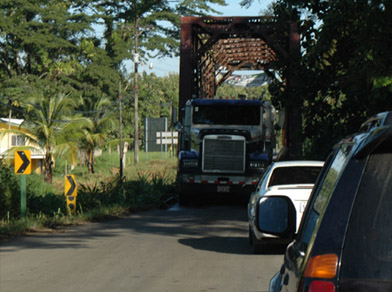 |
 | The Rio Pirris was a substantial river, and this photo illustrates the nature of the country: green and clean. We had an hour and a half drive to Carara Reserve, so we got to see some of the countryside. A nice beach area on the way, and lots of new condos going up. |
You could look up the Rio Pirris and see the green mountains. We passed a thick grove of small trees which we were told was a teak farm. This high quality rainforest hardwood could be harvested in about five years. The environmentally conscious Costa Ricans were quick to point out that they grew the hardwoods on farms rather than strip the old-growth rainforests. There was a lot of lush green pastureland, as you can see looking toward the mountains. We passed large groves of the African oil palm, the major agricultural crop in the Quepos area.

We arrived at the trail head of the longest of the two allowed trails into this carefully protected biological reserve. Diego took us in on what was a narrow dirt road. The trail is 4.4km long and there is another 1 km loop trail - otherwise the park is off limits. Shortly down the trail we saw this iguana up on a limb that overhung the trail at about 30 feet up. If you look closely you can see the steam rising from him and the limb in the morning sun.
We were headed into a dark, damp jungle area. The lower vegetation was tropical and palm-like, but there were towering hardwoods that formed a high canopy over us. Diego carried an amazing spotting scope on a tripod that enabled us to see some things that you just could not see with the unaided eye.
The trail into Carara was along a small road, and it was covered with mud and water in many places. We had been told that we would need boots for these jungle hikes, but we just hadn't been able to manage that with the tight schedules. So we just had to slog in with the shoes we had on.

This was my best picture of the most celebrated resident of the Carara Reserve, the scarlet macaw. It is a magnificent large bird, and loud! You don't have to wonder if it is in the area. There is a continuous loud raucous squawking that you can probably hear a mile away. Seeing them is another thing. It took me a long time and the coaching of Diego to find this one high in the canopy. He was probably nearly a hundred feet up, and the canopy is dark.
Being in a real jungle for the first time was an educational experience! With all the animals and birds, I had the over-optimistic view that it would be easy to get photos of them. But the jungle is dark! And the animals hide - they use the jungle to conceal themselves from their abundant predators, and a concealed animal is hard to photograph. We would hear what was probably a couple of dozen parakeets in a tree, loudly squawking, but you couldn't see a one of them. So I considered myself fortunate to get at least a couple of scarlet macaw pictures in the wild. |  |
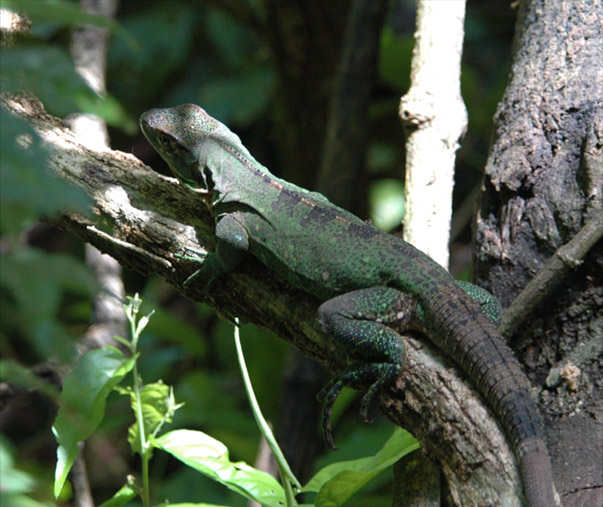
At least the iguanas were not so skittish and we saw lots of them. You would find them on the trail and they would move off into the jungle, but they didn't seem greatly alarmed. This one was callled a black spiny-tailed iguana, I think. | 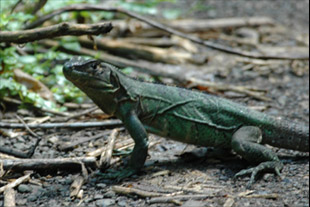 |
When we were some distance in along the trail, this small truck came through on the trail. Diego explained to us that there was a small remote village for which the only access was across the park.
We certainly felt we were in the jungle with the varieties of palm trees and bananas growing in the wild.
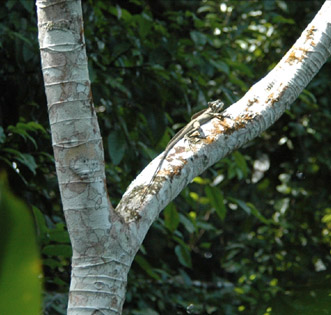 | We got a distant view of the basilisk lizard up on a tree. It is sometimes called the Jesus Christ lizard because it can run on water to escape its predators. The tree is significant, with a hollow trunk. It is protected by a fierce variety of ant in a symbiotic relationship, I understood, and it is a favorite food for sloths. |
We saw several bunches of wild bananas alongside the trail. They were about half the size of what we see in the grocery store, and I was surprised at the large stalk and flower associated with them. We heard the surprising news that the large bananas are bad for the monkeys - interfering with their reproduction, and that these small bananas are their natural food. |  | 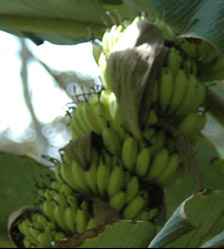 |
 | With the darkness of the jungle, there were not a lot of flowers to be seen. This plant was abundant and added color to the jungle trail. I think we have called it "bird of paradise" at home, but I heard it called "eyelash palm" there. The colorful part is not really a bloom, but a modified leaf designed to give color and attract pollinators more than the tiny flower would. |
There were times when the opening ahead looked more like a river than a trail.
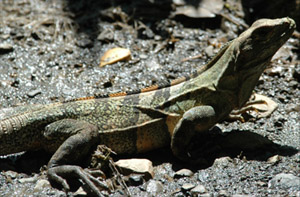 I liked the variety of iguanas we saw, and we saw two large paper wasp nests that you definitely wanted to leave alone. The plant variety was far in excess of the animal variety we saw, and I wish I had studied up more on them. | 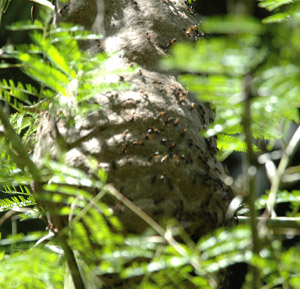 |
Diego called the tree that the wasps were on a bullhorn tree because it had thorns that looked like the horns of a bull. I continued to be intrigued by the fact that these tiny bananas that we found here had such a huge flower associated with them.
Most of the hardwoods that formed the canopy were in the range 60 to 90 ft probably, but this huge tree must have gone well over 100 feet, towering above everything.
It was hard to show the dual levels of the jungle. You were so immersed in the lower tropical growth like that above left that it was hard to get a clear view of the canopy. The view above right gives a little picture of it, making use of a small clearing where you can see the low growth but also the towering trees that contribute to the canopy.
Diego was keen on explaining to us the plants in the jungle that were edible. He pointed out that the flower of this plant could be picked and eaten and that you could squeeze the cone-shaped structure and get a significant amount of water to drink.
This was really the most amazing thing I saw on the jungle trail. This trail of leaf-cutter ants formed a column coming down one tree, across the width of the trail, up this big log and along it to another tree. Diego gave a figure for what percentage of the jungle foliage is recycled by the leaf-cutter ants. We saw two different columns of them and another column of what he called destroyer ants. This experience was later reinforced by an exhibit at the Insectarium in New Orleans.
We spent quite a while watching a troop of white faced or capuchin monkeys high in the canopy. Diego said it was the first time he had seen the capuchins in this area. It was nap time for the monkeys and they didn't want to be bothered by us. We could see them fairly well with binoculars and with Diego's spotter scope, but I couldn't get any good pictures at that range and in the shadow of the canopy.
We moved on along the wet trail, sometimes wading up to ankle deep.
 | We hiked to a marshy area where we were able to see the unique boat-billed heron. Diego told us that this bird never slept - it could put one side of its brain to sleep at a time and never be totally asleep. It didn't seem alarmed by us and stayed in this tree the whole time we were there. 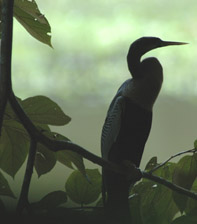 |
There were several anhingas drying their wings in the trees, and we got to watch a brown heron in the marsh hunting for lunch. So overall, the marsh was the place where we saw the most wildlife. We saw several other birds including a large kingfisher. We heard more scarlet macaws in the trees across the marsh, but never got a good look at them. | 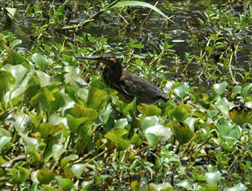 |
As we headed back from the marsh, we encountered yet another type of iguana, a brilliant green one. My overall impression of the jungle was of banana and palm type tropical plants growing in profusion in the darker lower level and towering hardwoods that put a high canopy over everything. I knew that from lots of films, but this is the first time I had seen it in person.
Diego wrote down his list of what we had seen on a small slip of paper for us: scarlet macaw, black-hooded ant-shrike, leaf-cutter ants, white-faced monkeys, anhinga, cormorant, boat-billed heron, black spiny-tailed iquana, heliconius butterfly, devastator ants, northern jacana and smooth-billed annie.
The tour provided a Costa Rican lunch for us in a sports cafe on the River where several guys were watching soccer on TV. That was quite nice. It started raining hard while we were there and we were glad we got out of the jungle when we did.
There was a torrential rainstorm all the way back, and when we got to Omygod bridge, you could hardly see for the rain. We had to wait about 20 minutes there for the traffic backup at the single lane bridge. Seeing the gaps in the walkway and the bridge, it was hard to believe it stood up to the heavy traffic it carried. We were glad Grandpa was driving, and it was nice to get back to Si Como No.
|
Index
2006
Costa Rica |




